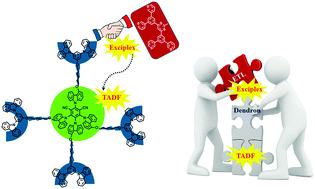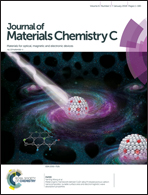Thermally activated delayed fluorescence dendrimers with exciplex-forming dendrons for low-voltage-driving and power-efficient solution-processed OLEDs†
Abstract
Exciplex-forming hosts have the excellent function of reducing driving voltages by eliminating the injection barrier, while thermally activated delayed fluorescence (TADF) emitters are able to realize 100% internal quantum efficiency. The marriage of exciplex and TADF should be a rational strategy to design ideal luminescent materials. In this study, two new dendrimers G-TCTA and G-mCP with a non-conjugated connection of the well-known efficient TADF core and different exciplex-forming dendrons were designed and synthesized. Both dendrimers possess excellent thermal stability, good solution processability, and an visible TADF feature. The non-conjugated connection can make the photophysical properties of TADF core and the exciplex-forming function of the dendrons independent. Consequently, a nondoped device of G-mCP achieves an extremely low driving voltage of 2.7 V and a high power efficiency of 46.6 lm W−1, which is among the highest power efficiency of the reported TADF s-OLED. We believe that this study would provide a simple and practical method to design novel power-efficient TADF dendrimers used for energy-saving displays and solid-state lightings.



 Please wait while we load your content...
Please wait while we load your content...